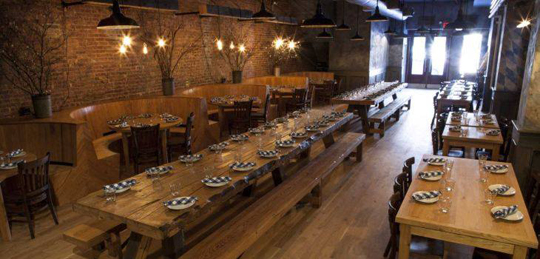Paulaner
 Tuesday, October 7, 2014 at 06:14AM
Tuesday, October 7, 2014 at 06:14AM 
 It’s hard to screw up a beer hall, but Paulaner nearly failed, opening in November 2013 and closing just five months later for “renovations”. Evidently, the original décor “felt too much like an Applebee’s and needed a stylish kick in the pants.”
It’s hard to screw up a beer hall, but Paulaner nearly failed, opening in November 2013 and closing just five months later for “renovations”. Evidently, the original décor “felt too much like an Applebee’s and needed a stylish kick in the pants.”
 Successful second acts are rare in the restaurant business, but there are solid names behind the revamp, which opened in May under new management. Wolfgang Ban (of Seäsonal, Edi & the Wolf, and The Third Man) and Stephen Starr vet Markus Tschuschnig are co-owners. The executive chef is Bavarian Daniel Kill, from Kurt Gutenbruner’s chain of Austrian restaurants (Wallsé, Blaue Gans, Café Sabarsky, The Upholstery Store).
Successful second acts are rare in the restaurant business, but there are solid names behind the revamp, which opened in May under new management. Wolfgang Ban (of Seäsonal, Edi & the Wolf, and The Third Man) and Stephen Starr vet Markus Tschuschnig are co-owners. The executive chef is Bavarian Daniel Kill, from Kurt Gutenbruner’s chain of Austrian restaurants (Wallsé, Blaue Gans, Café Sabarsky, The Upholstery Store).
I never visited Paulaner v1.0, but the redesign doesn’t seem that dramatic (see the before and after photos on Eater). Still, it is a clear improvement. Photos on the walls have been ditched, leaving bare brick. Tables are now a darker wood. The long center aisle of the dining room is now taken up with communal tables and wooden benches. At the edge of the room, a row of rectangular tables is replaced with half-moon shaped booths.
The restaurant remains affiliated with the German beer of the same name. At the back of the restaurant, there are two huge copper and stainless steel fermenting vats imported from Germany. Beers brewed on-site are served unfiltered and unpasteurized.
The menu is inexpensive, with starters (appetizers, cheeses and sausages) $9–14, entrées $14–23, and side dishes $5–7. Portion sizes are ample, as you’d expect in a German restaurant. There’s a modest wine list (all $10 a glass). Cocktails are $11; beers $5, $7, or $13, depending on the size. When was the last time you saw food and alcohol this cheap, at a place run by a Michelin-starred chef?













